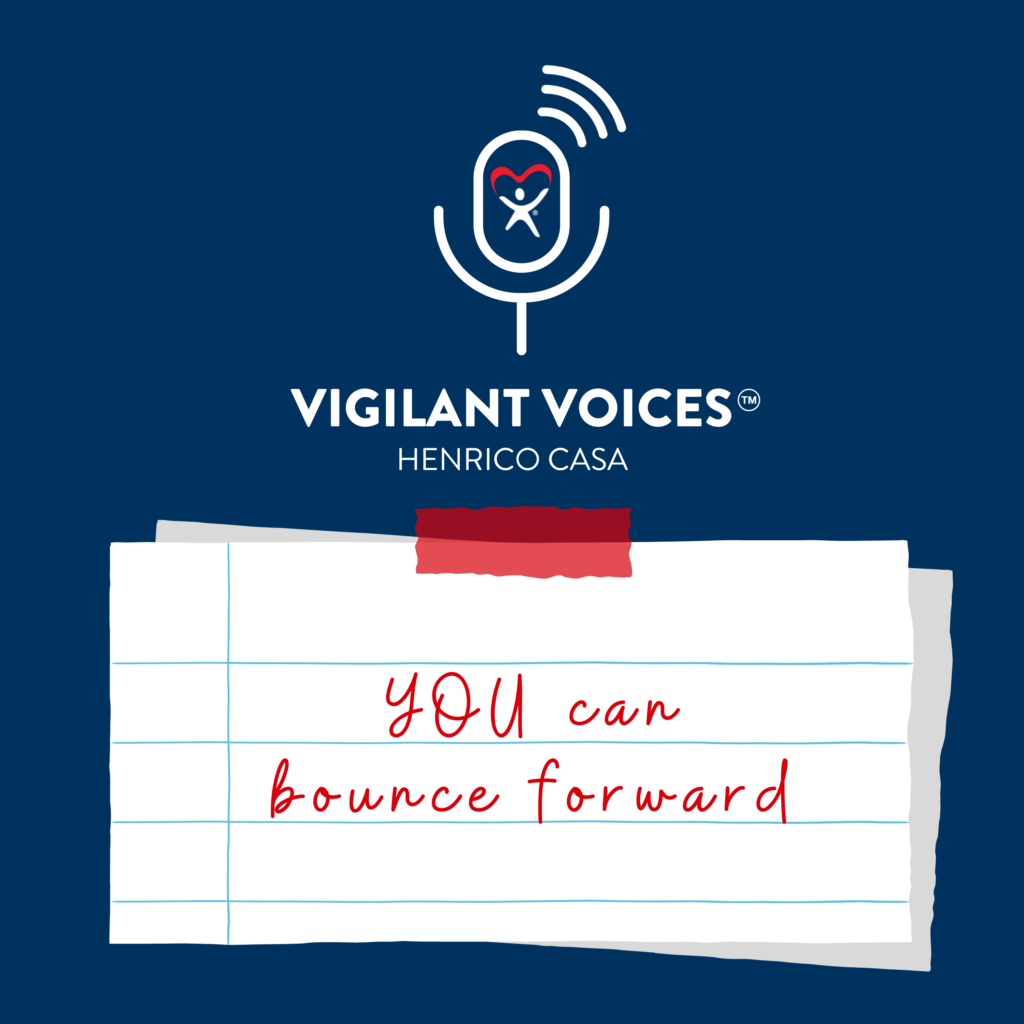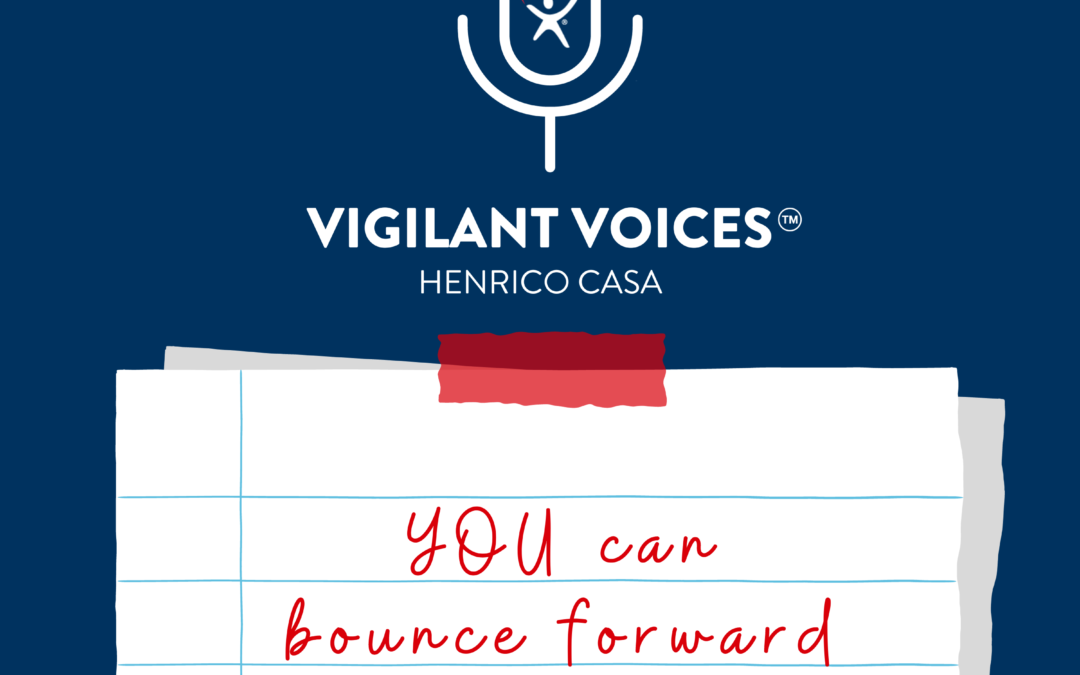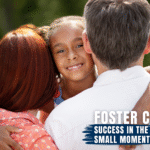
Listen to Episode 16 of the Vigilant Voices™ podcast, YOU Can Bounce Forward.
Jeannine Panzera: Hello listeners. We’re glad you are here with us for yet another episode of Vigilant Voices™.
Kristin Blalock: We’re always happy to spend time with you talking about topics related to children,
J: and these are children who have experienced abuse or neglect. And we want all of us to know more about the challenges facing children and families in order to help create a community where one day no child will face abuse, neglect or trauma.
K: And the unfortunate reality is that bad things do happen to children every day all around us. National data actually shows that 1 in 7 children experience abuse or neglect.
J: Even closer to home. We know that in Virginia, the statistics show that a child is abused or neglected every 81 minutes, which is heartbreaking.
K: Yeah. And if you look at other trauma, you know, beyond abuse and neglect, it shows that in Virginia, one child drops out of school every 69 minutes and a child becomes homeless every 25 minutes.
J: I mean, that is pretty astonishing. Yeah. And you know something about looking at at stats in these moments or that number of minutes, it really is attention grabbing. We grabbed these from this sheet called moments in Virginia we did really neat and it’s a data sheet that Families Forward publishes. So we’ll, we’ll make sure we link to that for you.
K: And one more moment that they publish to point out is that every 135 minutes a child in Virginia is served by a court appointed special advocate.
J: Yay! We are just so thankful for for that and the amazing people who volunteer to be these advocates.
K: Amazing people like one of our local advocates here in Henrico. We wanted to highlight her in today’s CASA case story. Barbara has served 35 children over her time as an advocate…
J: And is continuing to serve, so the number of children she has helped will keep growing.
K: Yes. Love that. One specific group of children is especially near and dear to her heart. There was a series of children born to the same biological mom. She lost custody of each of these children as they were born. Over the years, Barbara was reappointed to serve these children – and their new siblings that were to come – multiple times.
J: This is so sad because unfortunately this mom’s challenges were just too much to overcome to be able to raise these children safely.
K: Right. And when I think about these children, I’m just reminded that through no fault of their own were born into a really tough situation.
J: So tough. It’s amazing how children can bounce back from such a traumatic start to life.
K: That’s actually what we’re going to talk about today – everyone responds to trauma differently. How can we help them bounce back or even better, bounce forward?
J: Great question. And, listener, the term we use for this is ‘resilience.’ Resilience is about rebounding from adversity and overcoming or lessening the effects of trauma.
K: Right. I think everyone has a certain amount of inner strength or innate resilience… but it’s also an attribute that we can grow and strengthen. So ideally, we want to help children build up their resilience.
J: And that resilience will equip them to cope with stress, regulate their emotions, and form healthy attachments.
K: Before we dive into this more, I want to point out that studies show that the most critical component to a child building resilience is the presence of at least one positive person – a safe, trusted adult – in their life.
J: That’s one of the way our advocates help these children. By visiting them consistently and building a trusted relationship, our advocates are crucial to helping a child build resilience.
K: There are three aspects to building resilience that we wanted to talk through today. And some of the information we’re referencing comes from two articles on the topic that were published earlier this year. One by Jeremy Sutton and the other by Glenn Schiraldi. We’ll link to them in the show notes.
J: So, let’s dive in! The first aspect of resilience is recovery.
K: Right – this is the concept of returning to normal. You might know this term from the world of fitness – where it applies to recovering from a workout and returning to a normal heart rate.
J: In this context of childhood trauma, recovery is returning to a place of wellbeing. I started to say returning to “normal,” but for the children we work with, “normal” may not be healthy. So we’re not necessarily talking about returning to the people, places, and things in their live prior to the abuse and neglect. Instead, it is turning to a place of healthy functioning.
K: Yes. And children require a safe and supportive space to rebuild their sense of self.
J: Without a doubt. Some of the things we can do to help with this recovery stage are to create safe spaces for children
K: meaning physical spaces and emotional spaces.
J: Yes. Both are needed. And in the safe space, we can encourage kids to express themselves… articulate their emotions… say what’s on their mind…
K: And when we listen, we need to remember that everyone is different! There is no one right way to feel or right way to process what has happened to us. Every child will follow a different path to healing.
J: Definitely… and as they recover, another important aspect of building resilience is resistance. This is the child’s ability to prevent adverse affects from their trauma.
K: Again, if an exercise analogy is helpful, resistance workouts are when you push against a force… so in the world of childhood trauma, resistance is pushing back again against the negative outcomes that would typically be associated with their trauma.
J: For example… a child who learns to trust again… a child who doesn’t fall to addiction… a child who goes on to break generational cycles.
K: All great examples. And we can help support children by validating and encouraging them. We want them to be able to express their emotions without judgment. We want to offer them a nurturing environment so they can open up. We want them to be able to rebuild their sense of self-worth and agency.
J: Yes. And we also want to acknowledge their progress. Celebrating small wins can be a big thing to a child! Did they face a fear? Celebrate it! Did they express their emotion in a healthy way? Celebrate! Celebrate! Celebrate!
K: Yes – celebrate! You’ll help a child view themselves as capable and strong.
J: Ok. So we’ve talked about recovery and resistance as aspects of building resilience. Let’s also explain reconfiguration which is then redefining life after adversity. It’s kind of the idea of finding a new path…
K: like instead of just bouncing back, let’s help a child bounce forward…
J: bounce forward with different goals and expectations.
K: Going back to the fitness world analogies one more time, it’s like reconfiguring your body after physical trauma. Many people don’t just heal from their injury – they rebuild their bodies. They commit to becoming even stronger.
J: That is reconfiguration. And the best way to help children and teens with this is to speak words of encouragement into them.
K: Definitely. And, listener, don’t get hung up here. I know sometimes I stall on unique words of encouragement… like I don’t want to just give another generic “good job” to someone…
J: So true. Sometimes I lead into encouragement with questions – to help a child discover more about themselves. What interests you? What are you good at? What are your dreams?
K: Great thought – because then when you listen and respond to them, you can build them up and help them see that their identity isn’t defined solely by their past trauma.
J: And that can lead to goal setting – for the short term and long term. Speak into them – encouraging them to go after their goals. They can do it.
K: You could also encourage them to identify people – peers and adults – who would be great supports for them as they go after their goals. Encourage them to invest in these relationships.
J: So here’s the thing though… now that they’ve lived through trauma and started to build resilience, they aren’t just going to avoid all future difficulties.
K: Uh, there’s no magic wand for that.
J: But having resilience means facing difficulties with effective tools and coping strategies. As adults, we need to help children learn to manage their emotions, handle stress, and navigate challenges in healthy ways.
K: Which is exactly what the advocate, Barbara, in today’s CASA case did. She played a big part in helping the children build resilience. She was present to make the transition to a new home as smooth as possible. She showed up consistently to listen and encourage. She was supportive in helping the children navigate their new path forward. And those children are doing so well! Barbara gets photos and updates… including a recent back to school photo. They look so well-adjusted. She refers to them as survivors.
J: That they are. But we don’t want them to stop there. Yes, they survived… but we want them to thrive!
K: Part of what I think Barbara was really able to do for these kids was to help them rewrite their story. They aren’t defined only by their trauma. They aren’t only defined by the choices their biological mom made. Those are just some of many things that make them who they are.
J: And that is a great call to action for this episode. We encourage you, listener, to help a child redefine their narrative. Help them identify their strengths, their interests, their goals… Encourage them to create an image of who they are and what they want their future to look like…
K: And sometimes this means helping them put words around what they have experienced. Help them frame it and make the connections between that trauma and how it has shaped their present and their future.
J: Help them redefine their narrative and move towards a happy ending!








